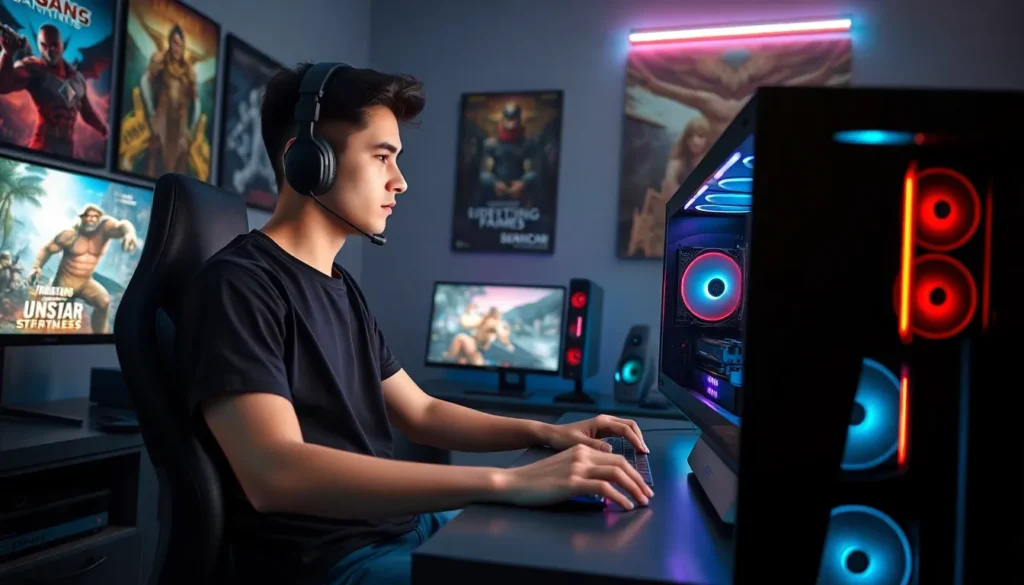Game streaming from a PC isn’t just a trend; it’s a revolution. Imagine sharing your epic gaming moments with the world while lounging in your pajamas. It’s like being a rock star without the pesky tour bus or the need to learn how to play an instrument. With just a few clicks, anyone can turn their living room into a virtual stage, showcasing their skills and entertaining friends or even strangers.
Table of Contents
ToggleOverview of Game Streaming From PC
Game streaming from a PC offers players a unique opportunity to connect with audiences worldwide. This platform enables gamers to broadcast their gameplay live, showcasing their talents and engaging with viewers in real-time. Several applications facilitate this process, including Twitch, YouTube Gaming, and Mixer, each providing various features designed to enhance the streaming experience.
Setting up a game stream involves several essential components. A high-performance PC equipped with a powerful graphics card and sufficient RAM ensures smooth gameplay. In addition, a stable internet connection with a minimum upload speed of 5 Mbps enhances stream quality, allowing viewers to enjoy high-definition video and clear audio. Streaming software, such as OBS Studio or Streamlabs, aids in capturing gameplay and adding overlays or alerts to engage viewers effectively.
Streaming also encourages community interaction. Gamers frequently use chat features to communicate with their audience, responding to questions and comments during gameplay. This interaction fosters a sense of connection, turning a solitary gaming experience into a shared event. Moreover, social media platforms can amplify reach, helping streamers attract larger audiences.
Monetization options exist for successful streamers. Advertisements, sponsorships, and viewer donations create income opportunities. Gamers can also earn money through affiliate marketing, promoting gaming products or services through their streams. As a result, game streaming has become a viable career option for many.
Game streaming from a PC transforms the gaming landscape. Its accessibility, community interaction, and monetization potential make it a compelling choice for both casual and professional gamers. As this trend continues to grow, more individuals are likely to explore the exciting world of game streaming.
Benefits of Game Streaming

Game streaming offers distinct advantages that enhance the gaming experience. Accessibility and community engagement play crucial roles in its appeal.
Accessibility and Convenience
Game streaming makes it easy for players to share content with global audiences. With just a high-performance PC and a stable internet connection, anyone can start streaming. Popular platforms like Twitch and YouTube Gaming simplify the broadcasting process. Users can stream directly from their computers with minimal setup. This convenience allows for on-the-go gaming and interaction without being tied to a specific location. Flexibility in scheduling also proves beneficial, as streamers can choose whenever to showcase their gameplay. Being able to engage audiences from home combines entertainment and accessibility seamlessly.
Community Engagement
Community interaction forms a vital part of the game streaming experience. Through chat features, streamers connect with viewers in real time. Engagement fosters a sense of belonging among players and fans alike. Streamers often respond to viewer comments, creating dynamic conversations and reinforcing community bonds. Loyalty from viewers often translates into consistent support, enhancing overall streaming success. Moreover, participating in community events and collaborations can expand a streamer’s reach. This interaction transforms solitary gameplay into a vibrant community experience, making it both fun and socially enriching.
Popular Game Streaming Platforms
Game streaming has gained immense popularity, with several platforms leading the charge. Each platform offers unique features and benefits for streamers and viewers alike.
Twitch
Twitch stands as the most renowned game streaming platform. This platform attracts millions of viewers daily, making it a prime destination for gamers. Streamers can connect with their audience through chat interactions, fostering community engagement. Various categories are available, including esports, casual gaming, and creative streams. Twitch also offers monetization options, such as subscriptions, ads, and donations, providing incentives for dedicated streamers. Users appreciate the platform’s emphasis on real-time interaction, which enhances the overall viewing experience.
YouTube Gaming
YouTube Gaming serves as a powerful competitor to Twitch. This platform integrates seamlessly with the existing YouTube infrastructure, allowing access to a vast audience. Content creators can upload edited gaming videos alongside live streams. Features like Super Chat and channel memberships enable streamers to monetize their streams effectively. The platform also supports uploads of past streams, making previous content easily accessible. Users benefit from YouTube’s extensive library, contributing to a rich viewing experience.
Facebook Gaming
Facebook Gaming is gaining traction in the streaming landscape. This platform leverages Facebook’s massive user base for effective audience outreach. Streamers can easily promote their channels through friends and groups, enhancing visibility. Interactive features such as live comments and reactions create a dynamic engagement atmosphere. Additionally, Facebook Gaming supports monetization through stars and fan subscriptions, making it appealing for content creators. The integration with other Facebook services allows for an enriched community experience, fostering loyal viewer relationships.
Hardware Requirements for Game Streaming
Game streaming demands specific hardware to ensure a smooth experience. Below are the essential specifications for both minimum and recommended setups.
Minimum Specs
For basic game streaming capabilities, a few key components are necessary. A processor such as Intel Core i5 or AMD Ryzen 5 provides decent performance for most games. The minimum RAM should be 8 GB, allowing for efficient multitasking while streaming. An NVIDIA GTX 660 or AMD Radeon HD 7870 graphics card delivers acceptable visuals for entry-level streaming. Ensure a stable internet connection with upload speeds of at least 3 Mbps to maintain stream quality.
Recommended Specs
For optimal game streaming, investing in higher-end hardware enhances performance significantly. Select a processor like Intel Core i7 or AMD Ryzen 7 for better gameplay and encoding. Using 16 GB of RAM reduces load times and improves multitasking, especially during intense gaming sessions. A powerful graphics card, such as the NVIDIA RTX 2060 or AMD RX 5600 XT, supports high-resolution streaming with smooth frame rates. Aim for internet upload speeds of 10 Mbps or more to keep the stream stable and crystal clear.
Software Options for Game Streaming
Game streaming requires reliable software to ensure a smooth and engaging experience for both the streamer and the audience. Several options exist, each with unique features and capabilities.
Streaming Software Overview
OBS Studio stands out as a popular choice due to its open-source nature and flexibility. Users appreciate its extensive customization options, which cater to different streaming needs. Streamlabs OBS combines all essential features with an intuitive interface, making it beginner-friendly. XSplit offers a premium solution with advanced broadcasting capabilities, particularly for those seeking professional-quality streams. Each software option enables streamers to capture gameplay, integrate overlays, and manage audio settings seamlessly.
Configuration Tips
Optimize settings to enhance stream quality. Start by adjusting the resolution and bitrate based on internet speed and hardware capabilities. For standard streaming, a resolution of 720p and a bitrate between 2500 to 4000 Kbps work effectively. Customize scenes for different moments, utilizing overlays and alerts to interact with viewers. Test audio levels to ensure voice and game sounds are balanced, creating a more immersive experience. Frequent testing before going live helps troubleshoot any issues and refine settings.
Game streaming from a PC is reshaping the gaming landscape in exciting ways. It’s not just about playing games; it’s about sharing experiences and building communities. With the right setup and engagement strategies, anyone can become a successful streamer and connect with audiences worldwide.
The potential for monetization adds another layer of appeal, making it a viable career path for dedicated gamers. As technology continues to evolve, the future of game streaming looks promising, offering endless opportunities for creativity and interaction. Embracing this trend can lead to fulfilling experiences both for streamers and their viewers alike.








